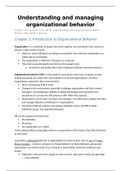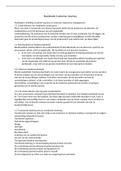Samenvatting
Understanding and Managing Organizational Behavior - Summary
- Instelling
- Universiteit Leiden (UL)
This is an English summary of the organizational book "Understanding and Managing Organizational Behavior" (Edition 6) for the forst year course Social and Organizational Psychology. It contains the relevant chapters for the exam in 2018, chapter 1, 3, 4, 6, 7, 8, 9, 10, 11 12, 13, 15. It is pretty...
[Meer zien]






